CHEVROLET CAMARO 1967 1.G Chassis Workshop Manual
Manufacturer: CHEVROLET, Model Year: 1967, Model line: CAMARO, Model: CHEVROLET CAMARO 1967 1.GPages: 659, PDF Size: 114.24 MB
Page 371 of 659

CLUTCH AND TRANSMISSIONS 7-12
DIAGNOSIS-OVERDRIVE
MECHANICAL
Any one of the following general complaints may be due
to non-standard mechanical conditions in the overdrive
unit:
1.
Does not drive unless locked up manually.
2.
Does not engage, or lock-up does not release.
3.
Engages with a severe jolt, or noise.
4.
Free-wheels at speeds over 30 mph.
These^ troubles may be diagnosed and remedied as de-
scribed in the following paragraphs.
1.
Does not drive unless locked up manually.
a. Occasionally, the unit may not drive the car for-
ward in direct drive, unless locked up by pulling
the dash control. This may be caused by one or
more broken rollers in the roller clutch, the
remedy for which is the replacement of the entire
set of rollers.
b.
This may also be caused by sticking of the roller
retainer upon the cam. This retainer must move
freely to push the rollers into engaging position,
under the pressure of the two actuating springs.
c. Sometimes this is due to slight indentations, worn
in the cam faces by the rollers spinning, remedied
by replacement of the cam.
2.
Does not engage, or lock-up does not release
.. a. Dash control improperly connected—-Unless the
overdrive dash control wire is connected to the
lockup lever on the left side of the overdrive
housing in such a manner as to move the lever
all the way back when the dash control knob is
pushed in, it may hold the shift rail in such a po-
sition as to interlock the pawl against full engage-
ment resulting in a buzzing noise when overdrive
engagement is attempted.
To correctly make this connection, loosen bind-
ing post at lever, pull dash control knob out 1/4",
move lever all the way to the rear, and tighten
binding post.
b.
Transmission and overdrive improperly aligned—
The same symptoms as above may also result
from misalignment, at assembly, of the overdrive
housing to the transmission case, resulting in
binding of the overdrive shift rail, so that the re-
tractor spring cannot move the rail fully forward,
when the dash control knob is pushed in, and the
transmission is not in reverse. Under such con-
ditions, the unit may remain fully locked up.
To test for this, be sure that the transmission
is not in reverse; disconnect the dash control
wire from the lockup lever, and feel the lever for
free forward movement. If the lever can be
moved forward more than 1/4", it indicates that
misalignment probably exists. To correct this,
Jposen the capscrews between the overdrive hous-
ing and transmission case, and tap the adpater
plate and overdrive housing until a position is
found where the rail shifts freely; tighten cap-
screws.
c. Kickdown switch improperly adjusted—The posi-
tion of the kickdown switch should be adjusted,
by means of the two large nuts which clamp the
switch shank, so the switch plunger travels 3/16"
before the throttle lever touches its stop.
Occasionally the large nuts which clamp the
switch through the switch bracket are tightened
sufficiently to bend the switch shank, thus pre-
venting free motion of the switch stem. This may
usually be remedied by loosening the upper of the
two nuts.
d. Improper installation of solenoid—If car cannot
be rolled backward under any circumstances and
there is no relay click when the ignition is turned
on, it probably indicates that the solenoid has
been installed directly, without twisting into the
bayonet lock between solenoid stem and pawl, thus
jamming the pawl permanently into overdrive en-
gagement. If the car will occasionally roll back-
wards, but not always, (and there is no relay click
when the ignition switch is turned on) it may indi-
cate that, upon installation, the bayonet lock was
caught, and the solenoid forcibly twisted into
alignment with the attaching flange, thus shearing
off the internal keying of the solenoid. Under
these circumstances, the end of the solenoid stem
may not catch in the pawl, and upon release of the
solenoid, the pawl will not be withdrawn promptly
from engagement, but simply drift out. If the
solenoid stem end has its two flats exactly facing
the two solenoid flange holes, it will not withdraw
the pawl properly. If the stem can be rotated
when grasped by a pair of pliers, it indicates that
the internal keying has been sheared.
e. Improper positioning of blocker ring—Occasion-
ally, either in assembly at the factory, or in
service operations in the field, the internal parts
of the overdrive unit may have been rotated with
the solenoid pawl removed, causing the blocker
ring to rotate, so that its two lugs are not located
with respect to- the pawl as shown in Figure 12B.
In other words, the solid portion of the blocker
ring may be in alignment with the pawl, which will
prevent fill} engagement of the pawl with the sun
gear control plate/
To test for this condition, remove solenoid
cover, pull dash control knob out, roll car 2 ft.
forward. Push dash control in, turn ignition
switch on. Then ground the "KD" terminal of
relay, and watch movement of center stem of
solenoid. It should not move more than 1/8" when
the solenoid clicks. Then, with the relay terminal
still grounded, shift into low gear, and roll car
forward by hand. Solenoid stem should then move
an additional 3/8", as the pawl engages fully.
These two tests indicate proper blocker action.
Unless both tests are met, the blocker ring is
probably not in the correct position.
3.
Engages with a severe jolt or noise
Insufficient blocker ring friction may cause the ring
to lose its grip on the hub of the sun gear control
plate. Check the fit and tension of the ring as de-
scribed under "Cleaning and Inspection".
4.
Free-wheels at speeds over 30 MPH
If cam roller retainer spring tension is weak the unit
will free wheel at all times. Check spring action as
described under "Cleaning and Inspection".
CHEVROLET CHASSIS SERVICE MANUAL
Page 372 of 659
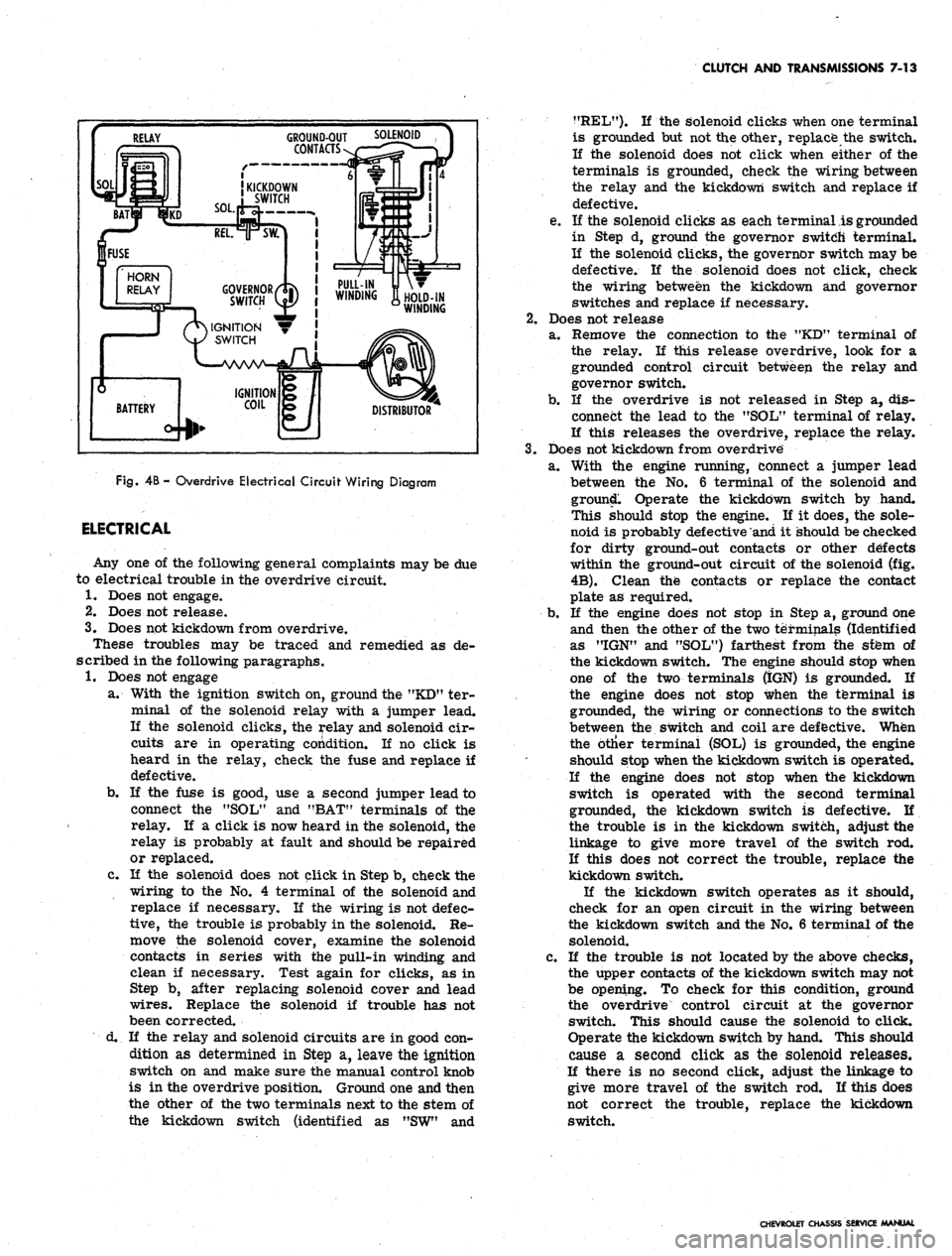
CLUTCH AND TRANSMISSIONS 7-13
PULL-IN
WINDING
li
HOLD-IN
WINDING
Fig.
4B -
Overdrive Electrical Circuit Wiring Diagram
ELECTRICAL
Any one of the following general complaints may be due
to electrical trouble in the overdrive circuit.
1.
Does not engage.
2.
Does not release.
3.
Does not kickdown from overdrive.
These troubles may be traced and remedied as de-
scribed in the following paragraphs.
1.
Does not engage
a. With the ignition switch on, ground the "KD" ter-
minal of the solenoid relay with a jumper lead.
If the solenoid clicks, the relay and solenoid cir-
cuits are in operating condition. If no click is
heard in the relay, check the fuse and replace if
defective.
b.
If the fuse is good, use a second jumper lead to
connect the "SOL" and "BAT" terminals of the
relay. If a click is now heard in the solenoid, the
relay is probably at fault and should be repaired
or replaced.
c. If the solenoid does not click in Step b, check the
wiring to the No. 4 terminal of the solenoid and
replace if necessary. If the wiring is not defec-
tive,
the trouble is probably in the solenoid. Re-
move the solenoid cover, examine the solenoid
contacts in series with the pull-in winding and
clean if necessary. Test again for clicks, as in
Step b, after replacing solenoid cover and lead
wires.
Replace the solenoid if trouble has not
been corrected.
d. If the relay and solenoid circuits are in good con-
dition as determined in Step a, leave the ignition
switch on and make sure the manual control knob
is in the overdrive position. Ground one and then
the other of the two terminals next to the stem of
the kickdown switch (identified as "SW" and
?fREL"). K the solenoid clicks when one terminal
is grounded but not the other, replace the switch.
If the solenoid does not click when either of the
terminals is grounded, check the wiring between
the relay and the kickdown switch and replace if
defective.
e. If the solenoid clicks as each terminal is grounded
in Step d, ground the governor switch terminal.
If the solenoid clicks, the governor switch may be
defective. If the solenoid does not click, check
the wiring between the kickdown and governor
switches and replace if necessary.
2.
Does not release
a. Remove the connection to the "KD" terminal of
the relay. If this release overdrive, look for a
grounded control circuit between the relay and
governor switch.
b.
If the overdrive is not released in Step a, dis-
connect the lead to the "SOL" terminal of relay.
If this releases the overdrive, replace the relay.
3.
Does not kickdown from overdrive
a. With the engine running, connect a jumper lead
between the No. 6 terminal of the solenoid and
ground. Operate the kickdown switch by hand.
This should stop the engine. If it does, the sole-
noid is probably defective and it should be checked
for dirty ground-out contacts or other defects
within the ground-out circuit of the solenoid (fig.
4B).
Clean the contacts or replace the contact
plate as required.
b.
If the engine does not stop in Step a, ground one
and then the other of the two terminals (Identified
as "IGN" and "SOL") farthest from the sfem of
the kickdown switch. The engine should stop when
one of the two terminals (IGN) is grounded. If
the engine does not stop when the terminal is
grounded, the wiring or connections to the switch
between the switch and coil are defective. When
the btlier terminal (SOL) is grounded, the engine
should stop when the kickdown switch is operated.
If the engine does not stop when the kickdown
switch is operated with the second terminal
grounded, the kickdown switch is defective. If
the trouble is in the kickdown switch, adjust the
linkage to give more travel of the switch rod.
If this does not correct the trouble, replace the
kickdown switch.
If the kickdown switch operates as it should,
check for an open circuit in the wiring between
the kickdown switch and the No. 6 terminal of the
solenoid.
c. If the trouble is not located by the above checks,
the upper contacts of the kickdown switch may not
be opening. To check for this condition, ground
the overdrive control circuit at the governor
switch. This should cause the solenoid to click.
Operate the kickdown switch by hand. This should
cause a second click as the solenoid releases.
If there is no second click, adjust the linkage to
give more travel of the switch rod. If this does
not correct the trouble, replace the kickdown
switch.
CHEVROLET CHASSIS SERVICE MANUAL
Page 373 of 659

CLUTCH AND TRANSMISSIONS 7-14
SPEED HEAVY DUTY TRANSMISSION
(WARNER MODEL T 16)
INDEX
General Description ......
Maintenance and Adjustments
Shift Linkage Adjustment
Side Cover ........
Removal .........
Disassembly
7-14
7-14
7-14
7-14
7-14
7-14
Assembly 7-14
Installation • 7-15
Other Maintenance
&
Adjustment
Operations See 3-Speed Saginaw Section
Transmission Replacement . . . See 3-Speed Saginaw Section
GENERAL DESCRIPTION
The Borg-Warner heavy duty three speed fully syn-
chronized (all forward gears) transmission incorporates
helical gears throughout specially designed to provide
high torque capacity, and gear teeth proportion to operate
at high speeds with neither excessive heat generation nor
excessive frictional losses. Shafts, bearings, high ca-
pacity clutches and other precision parts are held to
close limits providing proper clearances necessary for
durability during extended heavy usage.
The main drive gear is supported by a heavy duty ball
bearing at the front end of the transmission case and is
piloted at its front end in an oil impregnated bushing
mounted in the engine crankshaft. The front end of the
mainshaft is piloted in a row of roller bearings set into
the hollow end of the main drive gear and the rear end
is carried by a heavy duty ball bearing mounted in the
front of the extension housing.
The countergear is carried on a double row of rollers
at both ends while thrust is taken on thrust washers lo-
cated between the ends of the gear and the thrust bosses
in the case. An anti-rattle plate assembly at the front
of the countergear provides a constant spring tension be-
tween the counter and clutch gears to reduce torsional
vibrations. The reverse idler gear is carried on 25
roller bearings while thrust is taken on thrust washers
located between the ends of the gear and the thrust bosses
of the case.
Gear shifting is manual through shift control rods from
the shifter tube in the mast jacket to the rearward shift
lever of the side cover assembly for first and reverse
gear; and through a cross shaft assembly attached to the
forward side cover lever for second and third gear. All
three forward gears are fully synchronized. The syn-
chronizer assemblies consist of a clutch hub, clutch
sleeve, two clutch key springs and three energizer clutch
keys and are retained as an assembly on the main shaft
by a snap ring. The transmission may be used as an aid
in deceleration by downshifting in sequence without
double-clutching or any gear clashing. Reverse is not
synchronized, however, it is a helical gear to insure
quiet operation.
MAINTENANCE AND ADJUSTMENTS
Refer to similar procedures under the 3-speed Saginaw
Transmission Section for—Column Mounted Shift Linkage
Adjustment, Speedometer Driven Gear and Oil Seal Re-
placement, Extension Oil Seal Replacement and Trans-
mission Replacement. ~~
Camaro and Corvette Floor Shift Linkage Adjustment
(Fig.
lc)
1.
Set Lever (L), (K) in neutral position.
2.
Move Lever Assembly (A) and Levers (C), (D) to
neutral position and insert Locating Gauge (B) into
control Lever Bracket Assembly.
3.,
Install Rod (H) with Retainer (M) on Lever (L).
4.
With two Jam Nuts (G), (E) and Swivel (F) loose on
Rod (H) insert and attach Swivel with Retainer (N)
to Lever (D).
5.
Repeat steps 3 and 4 for Rod (J) and Levers (C
&
K).
6. Remove' Locating Gauge and check shift to insure
proper operation.
SIDE COVER ASSEMBLY
Removal
1.
Drain transmission and disconnect control rod and
cross shaft from side cover levers. *
2.
Remove nine cap screws securing the transmission
side cover assembly to transmission, case and re-
move cover assembly, shifting forks, and gasket.
Disassembly (Fig. 2C) '
1.
Remove shifting forks from shift lever assemblies.
2.
Remove nut and lock washer from each shift lever
shaft.
3.
Remove outer shift levers and lightly tap shift lever
shafts from assembly.
4.
Remove two steel balls, poppet spring, interlock pin
and interlock sleeve from cover.
5.
Remove "O" ring seals from shift lever shafts.
Assembly (Fig. 2C)
1.
Install new "O" ring seals to shift lever shafts.
2.
Install low and reverse shifter shaft and plate as-
sembly to cover.
3.
Place shifter shaft and plate assembly in neutral po-
sition, middle detent, and install interlock sleeve,
ball, poppet spring and interlock pin.
4.
Install remaining poppet ball and then install second
and third shifter shaft and plate assembly.
NOTE: Installation is easiest if shifter shaft
and plate assembly passes over ball in its neu-
tral position.
5.
Check clearance between end of interlock sleeve and
shifter shaft and plate cams when one plate is in
neutral and the other is shifted into gear position.
CHEVROLET CHASSIS SERVICE MANUAL
Page 374 of 659
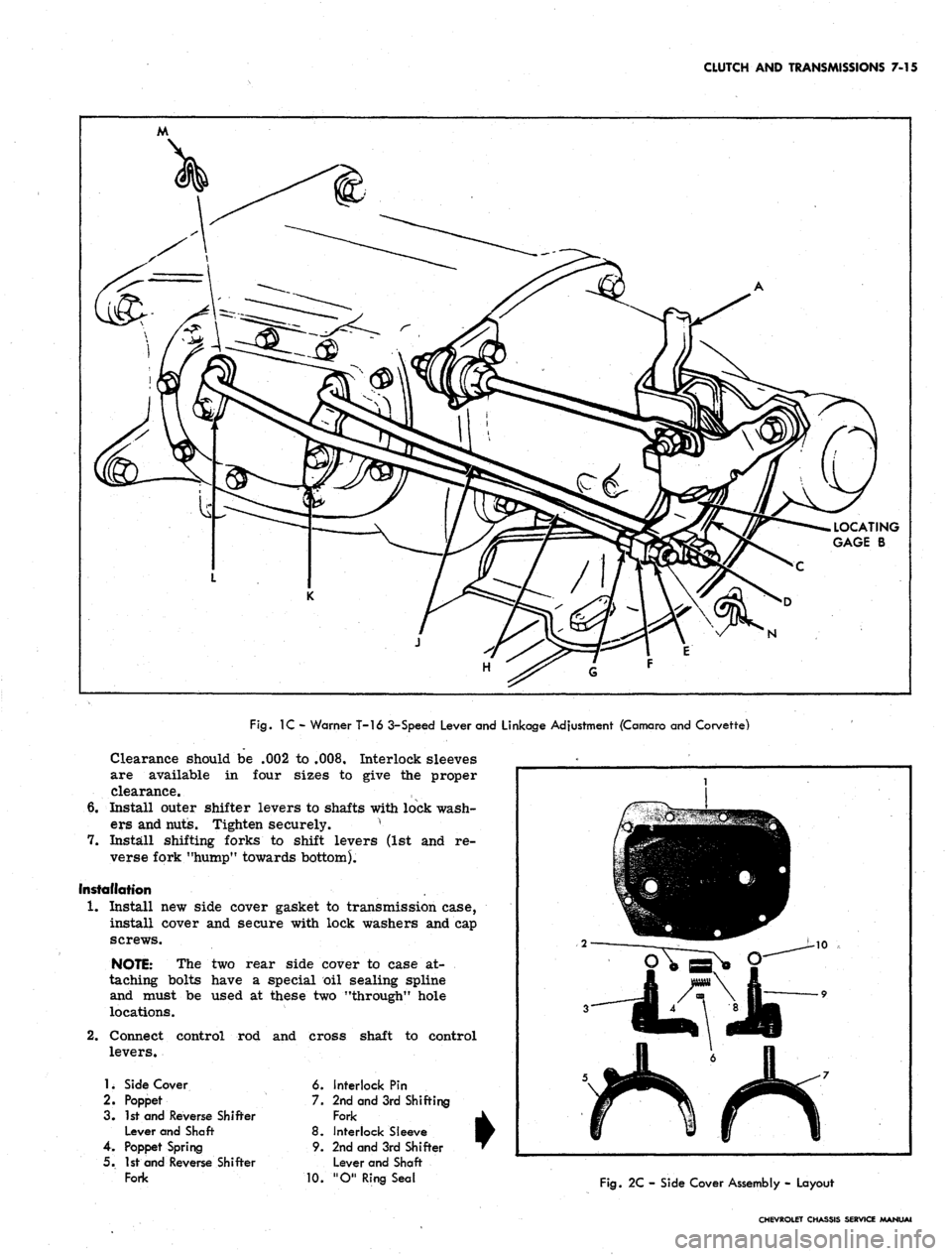
CLUTCH AND TRANSMISSIONS 7-15
LOCATING
GAGE B
N
Fig.
1C - Warner T-16 3-Speed Lever and Linkage Adjustment (Camaro and Corvette)
Clearance should be .002 to .008. Interlock sleeves
are available in four sizes to give the proper
clearance.
6. Install outer shifter levers to shafts with lock wash-
ers and nuts. Tighten securely. v
7.
Instill shifting forks to shift levers (1st and re-
verse fork "hump" towards bottom).
Installation
1.
Install new side cover gasket to transmission case,
install cover and secure with lock washers and cap
screws.
NOTE: The two rear side cover to case at-
taching bolts have a special oil sealing spline
and must be used at these two "through" hole
locations.
2.
Connect control rod and cross shaft to control
levers.
1.
Side Cover
2.
Poppet
3. 1st and Reverse Shifter
Lever and Shaft
4.
Poppet Spring
5. 1st and Reverse Shifter
Fork
6. Interlock Pin
7. 2nd and 3rd Shifting
Fork
8. Interlock Sleeve
9. 2nd and 3rd Shifter
Lever and Shaft
10.
"O11 Ring Seal
Fig.
2C - Side Cover Assembly - Layout
CHEVROLET CHASSIS SERVICE MANUAl
Page 375 of 659
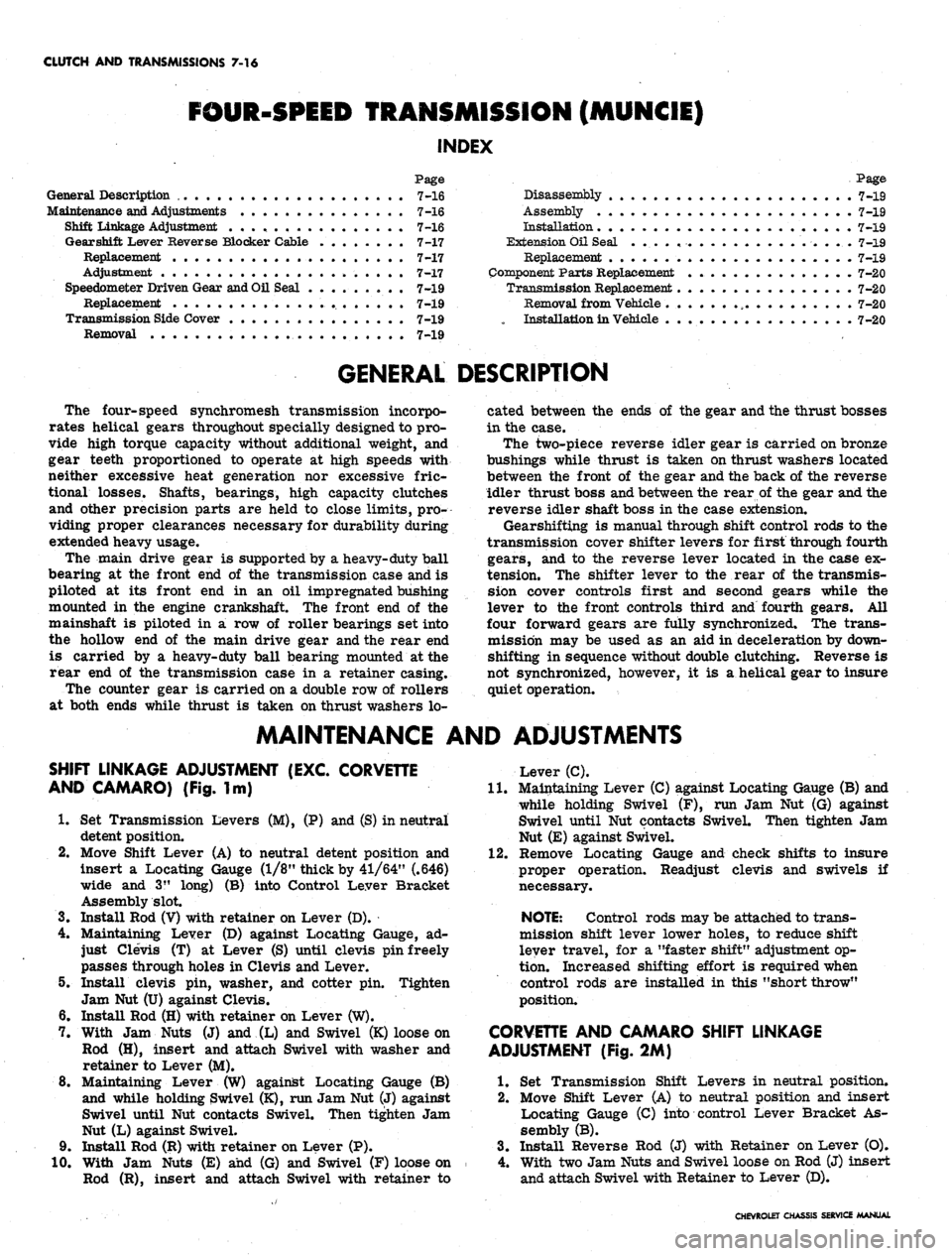
CLUTCH AND TRANSMISSIONS 7-16
FOUR-SPEED TRANSMISSION (MUNCIE)
INDEX
Page
General Description 7-16
Maintenance and Adjustments 7-16
Shift Linkage Adjustment 7-16
Gearshift Lever Reverse Blocker Cable 7-17
Replacement . 7-17
Adjustment 7-17
Speedometer Driven Gear and Oil Seal 7-19
Replacement 7-19
Transmission Side Cover 7-19
Removal 7-19
Page
Disassembly 7-19
Assembly 7-19
Installation . 7-19
Extension Oil Seal ......... 7-19
Replacement 7-19
Component Parts Replacement 7-20
Transmission Replacement 7-20
Removal from Vehicle , 7-20
. Installation in Vehicle . . . 7-20
GENERAL DESCRIPTION
The four-speed synchromesh transmission incorpo-
rates helical gears throughout specially designed to pro-
vide high torque capacity without additional weight, and
gear teeth proportioned to operate at high speeds with
neither excessive heat generation nor excessive fric-
tional losses. Shafts, bearings, high capacity clutches
and other precision parts are held to close limits, pro-
viding proper clearances necessary for durability during
extended heavy usage.
The main drive gear is supported by a heavy-duty ball
bearing at the front end of the transmission case and is
piloted at its front end in an oil impregnated bushing
mounted in the engine crankshaft. The front end of the
mainshaft is piloted in a row of roller bearings set into
the hollow end of the main drive gear and the rear end
is carried by a heavy-duty ball bearing mounted at the
rear end of the transmission case in a retainer casing.
The counter gear is carried on a double row of rollers
at both ends while thrust is taken on thrust washers lo-
cated between the ends of the gear and the thrust bosses
in the case.
The two-piece reverse idler gear is carried on bronze
bushings while thrust is taken on thrust washers located
between the front of the gear and the back of the reverse
idler thrust boss and between the rear of the gear and the
reverse idler shaft boss in the case extension.
Gearshifting is manual through shift control rods to the
transmission cover shifter levers for first through fourth
gears,
and to the reverse lever located in the case ex-
tension. The shifter lever to the rear of the transmis-
sion cover controls first and second gears while the
lever to the front controls third and fourth gears. All
four forward gears are fully synchronized. The trans-
mission may be used as an aid in deceleration by down-
shifting in sequence without double clutching. Reverse is
not synchronized, however, it is a helical gear to insure
quiet operation.
MAINTENANCE AND ADJUSTMENTS
SHIFT LINKAGE ADJUSTMENT (EXC. CORVETTE
AND CAMARO) (Fig. 1m)
1.
Set Transmission Levers (M), (P) and (S) in neutral
detent position.
2.
Move Shift Lever (A) to neutral detent position and
insert a Locating Gauge (1/8" thick by 41/64" (.646)
wide and 3" long) (B) into Control Lever Bracket
Assembly slot.
3.
Install Rod (V) with retainer on Lever (D).
4.
Maintaining Lever (D) against Locating Gauge, ad-
just Clevis (T) at Lever (S) until clevis pin freely
passes through holes in Clevis and Lever.
5. Install clevis pin, washer, and cotter pin. Tighten
Jam Nut (U) against Clevis.
6. Install Rod (H) with retainer on Lever (W).
7. With Jam Nuts (J) and (L) and Swivel (K) loose on
Rod (H), insert and attach Swivel with washer and
retainer to Lever (M).
8. Maintaining Lever (W) against Locating Gauge (B)
and while holding Swivel (K), run Jam Nut (J) against
Swivel until Nut contacts Swivel. Then tighten Jam
Nut (L) against Swivel.
9. Install Rod (R) with retainer on Lever (P).
10.
With Jam Nuts (E) and (G) and Swivel (F) loose on
Rod (R), insert and attach Swivel with retainer to
Lever (C).
11.
Maintaining Lever (C) against Locating Gauge (B) and
while holding Swivel (F), run Jam Nut (G) against
Swivel until Nut contacts Swivel. Then tighten Jam
Nut (E) against Swivel.
12.
Remove Locating Gauge and check shifts to insure
proper operation. Readjust clevis and swivels if
necessary.
NOTE:
Control rods may be attached to trans-
mission shift lever lower holes, to reduce shift
lever travel, for a "faster shift" adjustment op-
tion.
Increased shifting effort is required when
control rods are installed in this "short throw"
position.
CORVETTE AND CAMARO SHIFT LINKAGE
ADJUSTMENT (Fig. 2M)
1.
Set Transmission Shift Levers in neutral position.
2.
Move Shift Lever (A) to neutral position and insert
Locating Gauge (C) into control Lever Bracket As-
sembly (B).
3.
Install Reverse Rod (J) with Retainer on Lever (O).
4.
With two Jam Nuts and Swivel loose on Rod (J) insert
and attach Swivel with Retainer to Lever (D).
CHEVROLET CHASSIS SERVICE MANUAL
Page 376 of 659
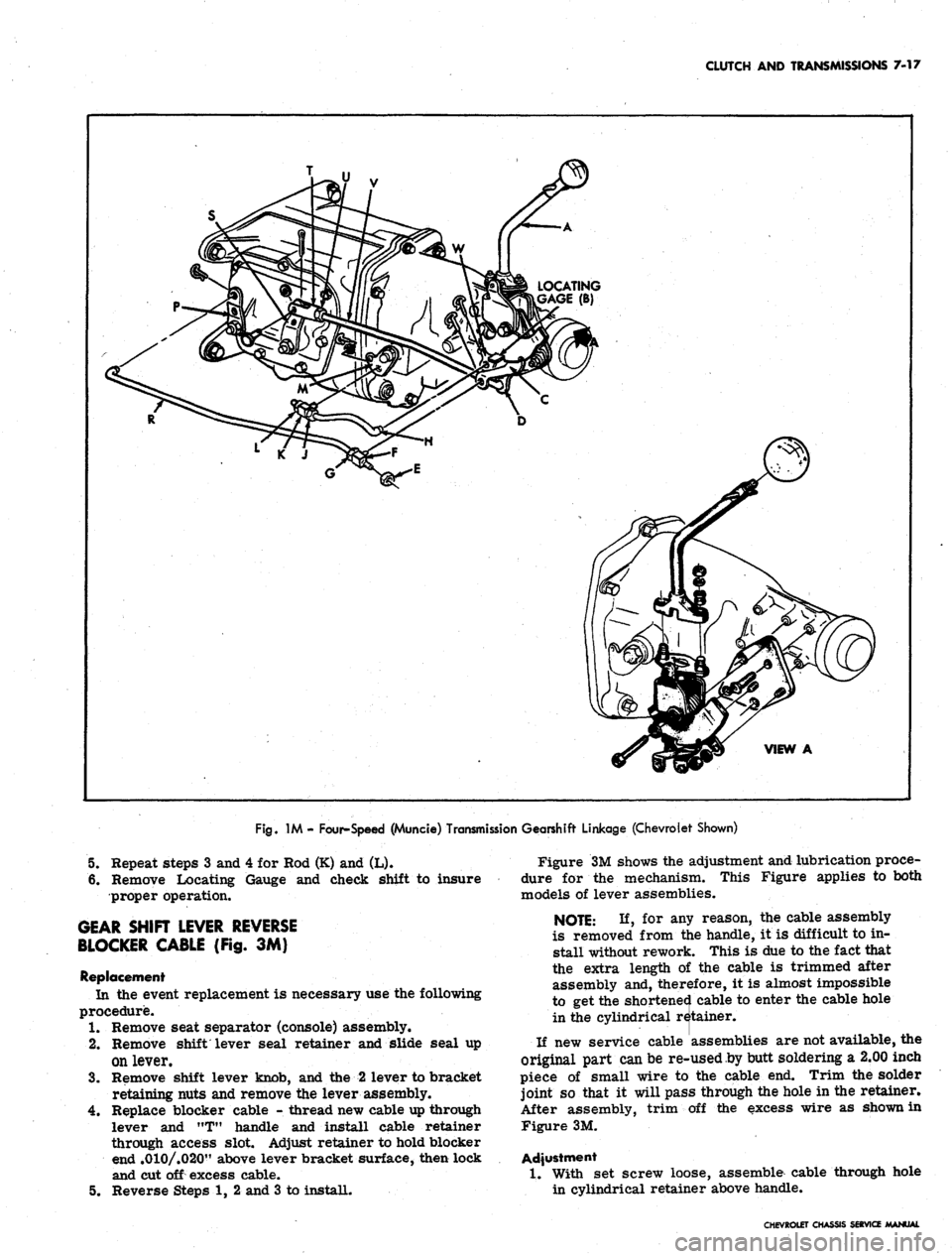
CLUTCH AND TRANSMISSIONS 7-17
VIEW A
Fig.
1M - Four-Speed (Muncie) Transmission Gearshift Linkage (Chevrolet Shown)
5.
Repeat steps 3 and 4 for Hod (K) and (L).
6. Remove Locating Gauge and check shift to insure
proper operation.
GEAR SHIFT LEVER REVERSE
BLOCKER CABLE (Fig. 3M)
Replacement
In the event replacement is necessary use the following
procedure.
1.
Remove seat separator (console) assembly.
2.
Remove shift lever seal retainer and slide seal up
on lever.
3.
Remove shift lever knob, and the 2 lever to bracket
retaining nuts and remove the lever assembly.
4.
Replace blocker cable - thread new cable up through
lever and MT" handle and install cable retainer
through access slot. Adjust retainer to hold blocker
end .010/.020" above lever bracket surface, then lock
and cut off excess cable.
5.
Reverse Steps 1, 2 and 3 to install.
Figure 3M shows the adjustment and lubrication proce-
dure for the mechanism. This Figure applies to both
models of lever assemblies.
NOTE: If, for any reason, the cable assembly
is removed from the handle, it is difficult to in-
stall without rework. This is due to the fact that
the extra length of the cable is trimmed after
assembly and, therefore, it is almost impossible
to get the shortened cable to enter the cable hole
in the cylindrical retainer.
If new service cable assemblies are not available, the
original part can be re-used by butt soldering a 2.00 inch
piece of small wire to the cable end. Trim the solder
joint so that it will pass through the hole in the retainer.
After assembly, trim off the excess wire as shown in
Figure 3M.
Adjustment
1.
With set screw loose, assemble cable through hole
in cylindrical retainer above handle.
CHEVROLET CHASSIS SERVICE MANUAL
Page 377 of 659
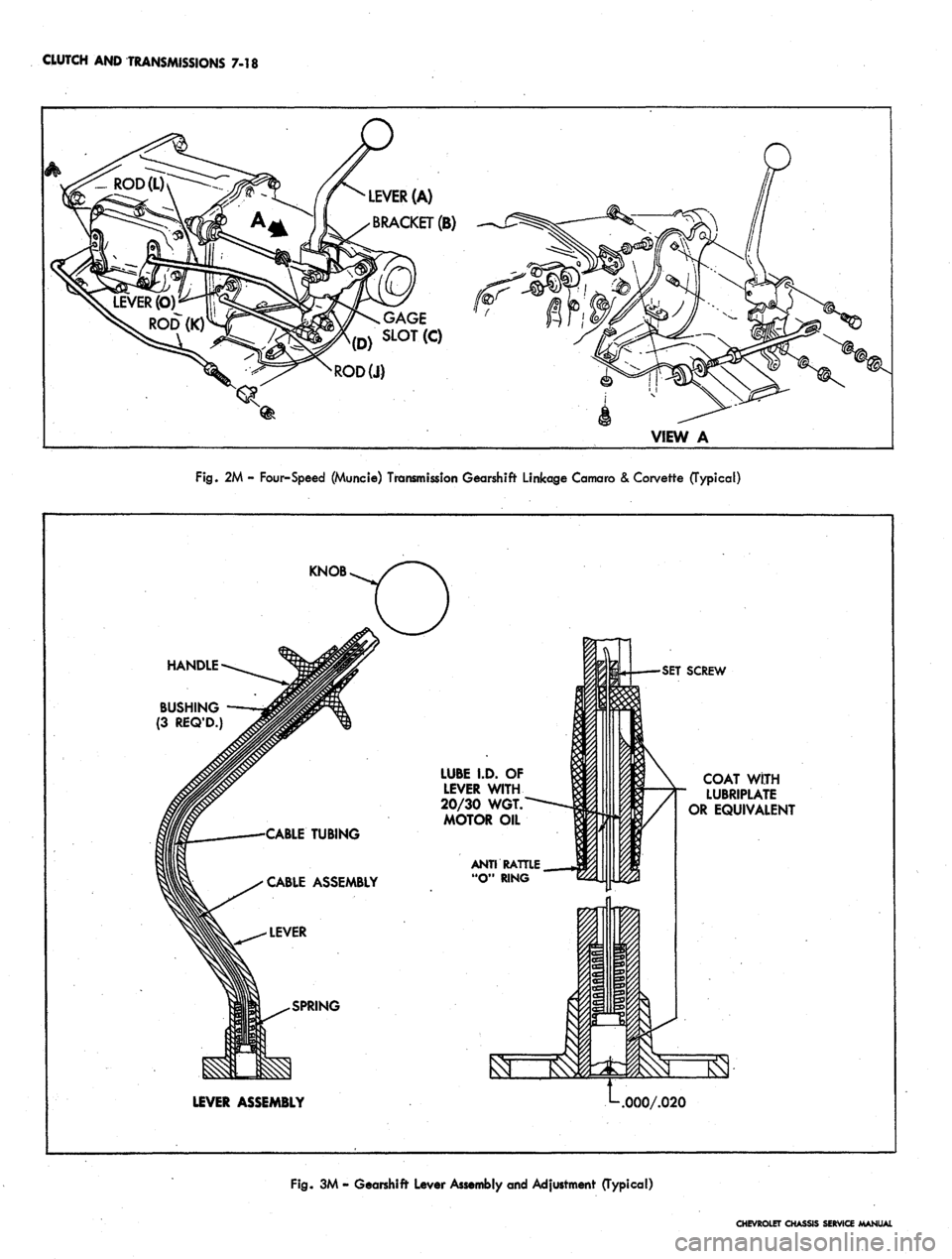
CWTCH AND TRANSMISSIONS 7-18
LEVER (A)
BRACKET (B)
GAGE
5LOT(C)
ROD(J)
VIEW A
Fig.
2M - Four-Speed (Muncie) Transmission Gearshift Linkage Camaro & Corvette (Typical)
HANDLE
BUSHING
(3 REQ'D.)
KNOB
CABLE TUBING
CABLE ASSEMBLY
LEVER
LEVER ASSEMBLY
LUBE I.D. OF
LEVER WITH
20/30 WGT.
MOTOR OIL
ANTI RATTLE
"O"
RING
SET SCREW
COAT WITH
LUBRIPLATE
OR EQUIVALENT
.000/.020
Fig.
3M - Gearshift- Lever Assembly and Adjustment (Typical)
CHEVROLET CHASSIS SERVICE MANUAL
Page 378 of 659
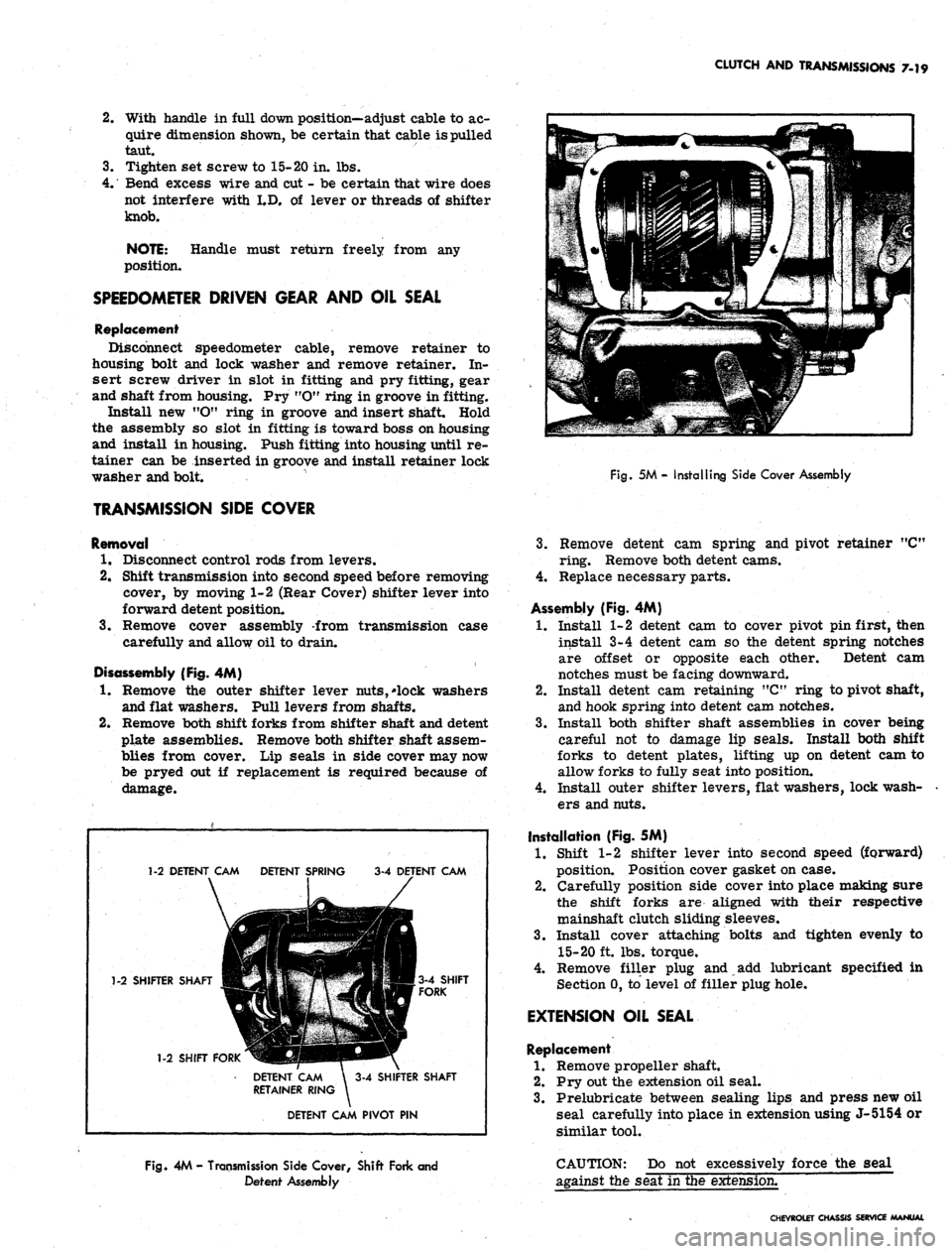
CLUTCH AND TRANSMISSIONS 7-19
2.
With handle in full down position—adjust cable to ac-
quire dimension shown, be certain that cable is pulled
taut.
3.
Tighten set screw to 15-20 in. lbs.
4.
Bend excess wire and cut - be certain that wire does
not interfere with I.D. of lever or threads of shifter
knob.
NOTE: Handle must return freely from any
position.
SPEEDOMETER DRIVEN GEAR AND OIL SEAL
Replacement
Disconnect speedometer cable, remove retainer to
housing bolt and lock washer and remove retainer. In-
sert screw driver in slot in fitting and pry fitting, gear
and shaft from housing. Pry "O" ring in groove in fitting.
Install new "O" ring in groove and insert shaft Hold
the assembly so slot in fitting is toward boss on housing
and install in housing. Push fitting into housing until re-
tainer can be inserted in groove and install retainer lock
washer and bolt.
Fig.
5M - Installing Side Cover Assembly
TRANSMISSION SIDE COVER
Removal
1.
Disconnect control rods from levers.
2.
Shift transmission into second speed before removing
cover, by moving 1-2 (Rear Cover) shifter lever into
forward detent position.
3.
Remove cover assembly -from transmission case
carefully and allow oil to drain.
Disassembly (Fig. 4M)
1.
Remove the outer shifter lever nuts,*lock washers
and flat washers. Pull levers from shafts.
2.
Remove both shift forks from shifter shaft and detent
plate assemblies. Remove both shifter shaft assem-
blies from cover. Lip seals in side cover may now
be pryed out if replacement is required because of
damage.
1-2 DETENT CAM DETENT SPRING
3-4 DETENT CAM
1-2 SHIFTER SHAFT
1-2 SHIFT FORK
3-4 SHIFT
FORK
DETENT CAM \ 3-4 SHIFTER SHAFT
RETAINER RING
DETENT CAM PIVOT PIN
3.
Remove detent cam spring and pivot retainer "C"
ring. Remove both detent cams.
4.
Replace necessary parts.
Assembly (Fig. 4M)
1.
Install 1-2 detent cam to cover pivot pin first, then
install 3-4 detent cam so the detent spring notches
are offset or opposite each other. Detent cam
notches must be facing downward.
2.
Install detent cam retaining "C" ring to pivot shaft,
and hook spring into detent cam notches.
3.
Install both shifter shaft assemblies in cover being
careful not to damage lip seals. Install both shift
forks to detent plates, lifting up on detent cam to
allow forks to fully seat into position.
4.
Install outer shifter levers, flat washers, lock wash-
ers and nuts.
Installation (Fig. 5M)
1.
Shift 1-2 shifter lever into second speed (forward)
position. Position cover gasket on case.
2.
Carefully position side cover into place making sure
the shift forks are aligned with their respective
mainshaft clutch sliding sleeves.
3.
Install cover attaching bolts and tighten evenly to
15-20 ft. lbs. torque.
4.
Remove filler plug and add lubricant specified in
Section 0, to level of filler plug hole.
EXTENSION OIL SEAL
Replacement
1.
Remove propeller shaft.
2.
Pry out the extension oil seal.
3.
Prelubricate between sealing lips and press new oil
seal carefully into place in extension using J-5154 or
similar tool.
Fig.
4M - Transmission Side Cover/ Shift Fork and
Detent Assembly
CAUTION: Do not excessively force the seal
against the seat in the extension.
CHEVROLET CHASSIS SERVICE MANUAL
Page 379 of 659

CLUTCH
AND
TRANSMISSIONS
7-20
COMPONENT PARTS REPLACEMENT
3.
4.
5.
6.
TRANSMISSION REPLACEMENT
(EXC.
CORVETTE)
Removal From Vehicle
1.
Remove shift lever trim plate and dust boot.
Remove shift lever assembly.
Raise vehicle
to
desired working height.
Disconnect
the
speedometer cable from speedometer
driven gear fitting.
.
~
. •
Remove propeller shaft, then support engine
at the
oil
pan
rail with
a
jack
or
other suitable support
capable
of
supporting
the
engine when transmission
is removed.
Disconnect shift lever bracket assembly from exten-
sion
and
remove
all 3
transmission shifter levers
from shifter shafts, (leave linkage connected
to
levers)
and
remove bracket assembly levers
and
linkage.
Remove extension mount7 to-crossmember attaching
bolts.
Loosen transmission crossmember
and
move rear-
ward
or
remove.
Remove
the
transmission-to-clutch housing retaining
bolts
and
install two guide pins, J-1126,
in
top holes.
Slide
the
transmission straight back until
the
input
shaft
is
free
of
splines
in the
clutch disc.
Slide
the
transmission rearward
to
allow sufficient
clearance
of
input shaft
and
clutch housing. Then tilt
input shaft
end of
transmission downward and with-
8.
9.
10.
11.
draw transmission from vehicle.
installation
to
Vehicle
1.
Raise transmission
and
rotate
as
necessary-to start
input shaft into clutch disc
and
slide transmission
forward until
it
bottoms against clutch housing.
Re-
move guide pins.
2.
Install
the
transmission-to-clutch housing retaining
bolts.
Torque
all
four retaining bolts
to 50 ft. lbs.
3.
Raise engine
and
position extension mount
to
cross-
member,
and
loosely install
the
retaining bolts.
Tighten crossmember
to
frame retaining bolts.
4.
Remove temporary support from engine, and torque
the extension mount retaining bolts.
5. Install propeller shaft.
6. Install control lever bracket assembly
to
transmis-
sion extension
and
connect shifter levers
to
shifter
shafts.
7. Fill transmission
to
level
of
filler plug hole with
correct lubricant specified
in
Section
0.
8. Lower vehicle and install shift lever assembly, check
shift pattern and adjust linkage
as
required.
9. Install trim plate and dust boot.
CORVETTE TRANSMISSION REPLACEMENT
Refer
to
similar procedure under 3-Speed Corvette
Transmission.
FOUR-SPEED (SAGINAW) TRANSMISSION
INDEX
Page
General Description
7-20
Maintenance
and
Adjustments
. . 7-21
Shift Linkage Adjustment.
. 7-21
Speedometer Driven Gear
and
Oil Seal ................
(See
Muncie 4-Speed)
Side Cover
7-22
Page
Removal
. . , 7-22
Disassembly
. . 7-22
Assembly
. . . 7-22
Installation
. 7-22
Extension
Oil
Seal
(See
Muncie 4-Speed)
Transmission Replacement (See Muncie 4-Speed)
GENERAL DESCRIPTION
The Saginaw four speed fully synchronized
(all
forward
gears) transmission incorporates helical drive gears
throughout.
The main drive gear
is
supported
by a
ball bearing
at
the front
end of the
transmission case and
is
piloted
at its
front
end in an oil
impregnated bushing mounted
in the
engine crankshaft.
The
front
end of the
mainshaft
is
piloted
in a row of
roller bearings
set
into
the
hollow
end
of
the
main drive gear
and the
rear end
is
carried
by a
ball bearing mounted
in the
front
of the
extension housing.
The countergear
is
carried
on a
single
row of
rollers
at both ends while thrust
is
taken on thrust washers
lo-
cated between
the
ends
of the
gear and
the
thrust bosses
in
the
case. Ah anti-rattle plate assembly
at the
front
of
the countergear provides
a
constant spring tension
be-
tween
the
counter
and
clutch gears
to
reduce torsional
vibrations.
The
sliding reverse idler gear
is
carried
on
a bushing finish bored
in
place.
It
rotates
on a
short
idler shaft retained by
a
woodruff
key.
The synchronizer assemblies consist
of a
clutch
hub,
clutch sleeve,
two
clutch
key
springs and three energizer
clutch keys
and are
retained
as an
assembly on
the
main
shaft
by a
snap ring.
A great deal
of
similarity
and
interchangeability
now
exists between
the new 3 and
4-speed Saginaw trans-
missions.
However,
the
synchronizer assembly
at the
front
of the
mainshaft
is
used
for the
third and fourth rather than
the
second
and
third shift.
The
synchronizer assembly
at
the rear
of the
mainshaft
is
used
for the
first and second
rather than
the
first
and
reverse shift. Gear teeth
cut
in
the
first and second synchronizer sleeve (reverse gear)
distinguish
it
from
the
third
and
fourth synchronizer
sleeve.
Starting from
the
front, gears
on the
mainshaft
are
third, second
and
first rather than second, first and
re-
verse.
A
fourth blocker ring
is
used between
the 1-2
synchronizer assembly
and
first gear
on the
four-speed
transmissions.
The cover
on the new
four-speed transmission
is lo-*
cated
on the
left-hand side
of the
case.
It is
similar
to
the three-speed cover with
the
addition
of a
reverse
shifter shaft assembly, detent ball
and
detent spring.
Disassembly
and
assembly procedures
are
covered
in
this section.
CHEVROLET CHASSIS SERVICE MANUAL
Page 380 of 659
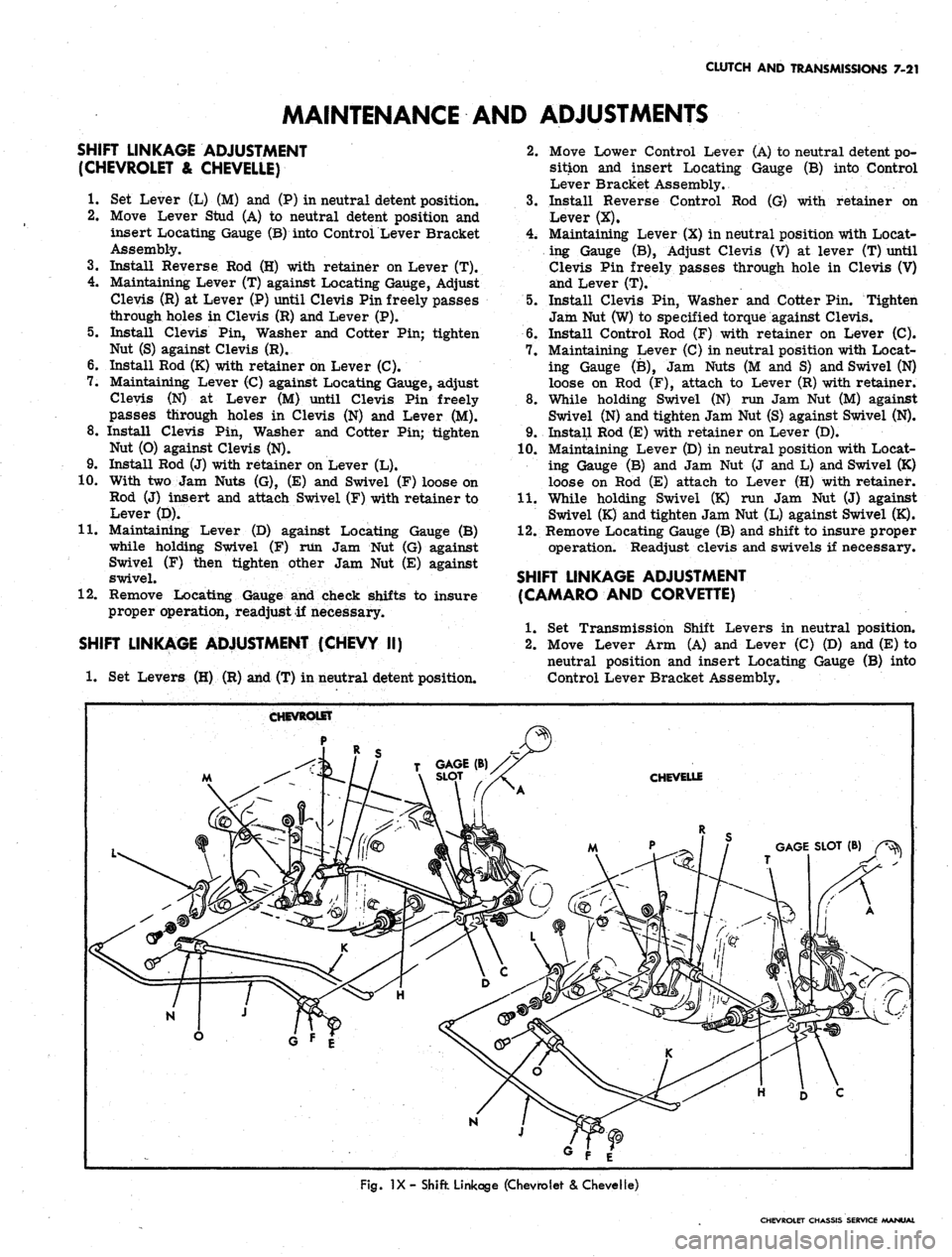
CLUTCH AND TRANSMISSIONS 7-21
MAINTENANCE AND ADJUSTMENTS
SHIFT LINKAGE ADJUSTMENT
(CHEVROLET & CHEVELLE)
1.
Set Lever (L) (M) and (P) in neutral detent position.
2.
Move Lever Stud (A) to neutral detent position and
insert Locating Gauge (B) into Control Lever Bracket
Assembly.
3.
Install Reverse Rod (H) with retainer on Lever (T).
4.
Maintaining Lever (T) against Locating Gauge, Adjust
Clevis (R) at Lever (P) until Clevis Pin freely passes
through holes in Clevis (R) and Lever (P).
5.
Install Clevis Pin, Washer and Cotter Pin; tighten
Nut (S) against Clevis (R).
6. Install Rod (K) with retainer on Lever (C).
7.
Maintaining Lever (C) against Locating Gauge, adjust
Clevis (N) at Lever (M) until Clevis Pin freely
passes through holes in Clevis (N) and Lever (M).
8. Install Clevis Pin, Washer and Cotter Pin; tighten
Nut (O) against Clevis (N).
9. Install Rod (J) with retainer on Lever (L).
10.
With two Jam Nuts (G), (E) and Swivel (F) loose on
Rod (J) insert and attach Swivel (F) with retainer to
Lever (D).
11.
Maintaining Lever (D) against Locating Gauge (B)
while holding Swivel (F) run Jam Nut (G) against
Swivel (F) then tighten other Jam Nut (E) against
swivel.
12.
Remove Locating Gauge and check shifts to insure
proper operation, readjust if necessary.
SHIFT LINKAGE ADJUSTMENT (CHEVY II)
1.
Set Levers (H) (R) and (T) in neutral detent position.
2.
Move Lower Control Lever (A) to neutral detent po-
sition and insert Locating Gauge (B) into Control
Lever Bracket Assembly.
3.
Install Reverse Control Rod (G) with retainer on
Lever (X).
4.
Maintaining Lever (X) in neutral position with Locat-
ing Gauge (B), Adjust Clevis (V) at lever (T) until
Clevis Pin freely passes through hole in Clevis (V)
and Lever (T).
5.
Install Clevis Pin, Washer and Cotter Pin. Tighten
Jam Nut (W) to specified torque against Clevis.
6. Install Control Rod (F) with retainer on Lever (C).
7.
Maintaining Lever (C) in neutral position with Locat-
ing Gauge (B), Jam Nuts (M and S) and Swivel (N)
loose on Rod (F), attach to Lever (R) with retainer.
8. While holding Swivel (N) run Jam Nut (M) against
Swivel (N) and tighten Jam Nut (S) against Swivel (N).
9. Install Rod (E) with retainer on Lever (D).
10.
Maintaining Lever (D) in neutral position with Locat-
ing Gauge (B) and Jam Nut (J and L) and Swivel (K)
loose on Rod (E) attach to Lever (H) with retainer.
11.
While holding Swivel (K) run Jam Nut (J) against
Swivel (K) and tighten Jam Nut (L) against Swivel (K).
12.
Remove Locating Gauge (B) and shift to insure proper
operation. Readjust clevis and swivels if necessary.
SHIFT LINKAGE ADJUSTMENT
(CAMARO AND CORVETTE)
1.
Set Transmission Shift Levers in neutral position.
2.
Move Lever Arm (A) and Lever (C) (D) and (E) to
neutral position and insert Locating Gauge (B) into
Control Lever Bracket Assembly.
N
f E
Fig.
IX - Shift. Linkage (Chevrolet & Chevelle)
CHEVROLET CHASSIS SERVICE MANUAL